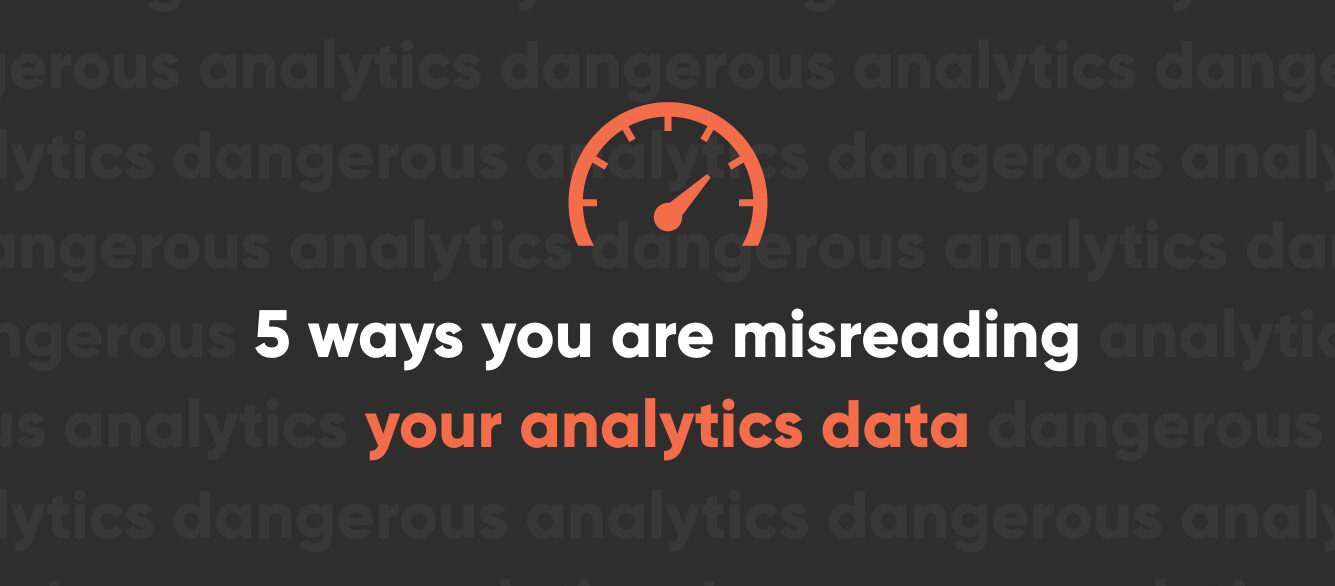
5 ways you are misreading your analytics data

Like an encyclopedia in the hands of an infant, all the data in the world won’t do you any good if you don’t know how to read it.
It can happen to anyone. Whether it’s your first time poring over a report or you’re a seasoned analytical professional, there’s a good chance you’re making some of the same mistakes when it comes to interpreting your website’s data.
From commonly incorrect assumptions to inadvertently misleading terminology, here are the 5 most likely ways you are misreading your analytics data.
1. Assuming a high bounce rate is bad
Bounce rates—contrary to popular belief—don’t refer to the percent of single-page visits to your site, but rather the percent of single-hit interactions. A user could visit only one page on your site, and it may not be registered as a bounce.
By adjusting your scroll tracking, for instance, you could artificially lower your bounce rate even though the same number of pages are being viewed.
|
Common misconception: A high bounce rate means your website is bad. |
A page with a high bounce rate isn’t necessarily bad. You first need to consider the purpose of the page. If it’s the home page, sure, that’s probably not a good sign. But if it’s a blog post that answers your viewers’ questions completely, that’s not a bad thing.
What should you do instead?
Rather than focus on the overall bounce rate, look at your:
- Bounce rate by page
- Bounce rate by device
- Bounce rate by campaign
- Bounce rate by content type
Find the ones that line up best with the goals of your site and use those numbers to come to a much more informed conclusion.
2. Thinking a low conversion rate is the end of the world
A conversion rate is the percentage of users who complete the desired goal out of the total number of visitors to your site.
|
Common misconception: A low conversion rate means your website is performing poorly. |
Conversion rates are often skewed by traffic that never has the opportunity or intent to convert. Before you jump to conclusions, you need to understand where all that traffic is coming from, and how much of it was never going to convert.
Let’s say you’re an eCommerce website, and you have a whole bunch of visitors that are only looking at your blog. Are those the visitors that are going to make a purchase? Probably not. (Although you could convert them another way, such as having them sign up for your newsletter.)
What should you do instead?
Home in on more specific conversion rates, such as:
- Percentage of product viewers who placed an order
- Percentage of contact page viewers who completed the form
- Percentage of online chats that led to a sale
- Percentage of visitors from a specific channel that converted
Don’t get hung up on what you can’t control. Focus your efforts on the needles you can move instead.
3. Prioritizing pageviews over conversions
Pageviews—as the name implies—is a count of each time a particular page is viewed. Pages per session, on the other hand, is the average number of pages a user looks at during a single visit to your site.
|
Common misconception: More page views and more pages per session is better. |
While this is certainly true if you’re monetizing your site with ads and need as many page views as possible, for most small to mid-sized businesses, this simply isn’t the case.
If your goal is to get people to buy a product, fill out a form, or make a phone call, you don’t need them to look at a ton of pages on your website—you need them to look at the right pages.
More pages per session doesn’t necessarily mean someone is more engaged with your site. It could mean they’re having trouble finding what they’re looking for or aren’t convinced by what you’re offering.
What should you do instead?
Your goal should be to get people to convert as quickly as possible. The longer they’re on your website, the more likely they’ll lose interest or get distracted by something else and ultimately fail to convert.
Pageviews are good, but conversions are better. If you shorten the path, more people will take the journey.
4. Not fully understanding direct traffic
Direct traffic typically consists of visitors that arrive directly on a website without having clicked on a link on another site or location.
|
Common misconception: Direct traffic is only those visitors that came to your site by typing in your URL. |
While this is certainly the case for a majority of direct traffic, it doesn’t account for all of it. The problem is, most analytics tools use direct traffic as a sort of catch-all for the traffic that doesn’t fit nicely into the other categories.
This could include:
- Links from emails that aren’t tagged
- Links from chats
- Links from sites that don’t pass referrals
- “Dark” social links (where nothing is tagged up)
- Even some organic search traffic “scraps”
Just because your direct traffic is up, doesn’t mean you should get all excited and cut your advertising spend.
What should you do instead?
Automation is a real lifesaver, but it’s far from perfect. If you don’t want anything to get reported to the wrong channel, use tracking codes on all of your campaigns.
5. Not recognizing bad data
Bad data, as you may have guessed, is any information that may mislead you or not give you the whole picture.
|
Common misconception: All analytics data is good data. |
Sometimes having too much data at your fingertips can be a bad thing if you don’t know how to spot the weeds. It’s quite likely that your analytics report is filled with bad data just waiting to lead you astray.
This could include:
- Bot traffic
- Internal traffic (your employees)
- Competitor traffic
- Spam traffic
- Unwanted international traffic
Not recognizing and filtering out this useless data can negatively impact your conversion rates, bounce rates, and many other reports.
What should you do instead?
Filter out or segment your bad data by using:
- ISP filters
- Internal filters
- Location filters
- Spam filters
This functionality is built into almost all analytics software, but you’ll need to go in and manually set it up to your parameters.
Still overwhelmed? It’s okay to seek help.
We get it. Your website is your baby. It’s hard to trust it in anyone else’s hands, no matter how overworked and overtired yours may be.
|
Common misconception: I don’t need to hire a professional. I can do it all myself. |
Whether your analytics reports are above your reading level or you don’t have the bandwidth required to dive deeper, it’s time to put an end to misread data.
What should you do instead?
Say hello to Perrill.
We are a full-service digital marketing agency experienced in creating and utilizing effective, readable reports in a way that drives our clients’ businesses forward.
Contact us today to start using your data to its fullest potential.





